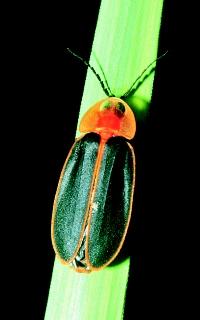Chickens Eating Worms that Glow
A Book Report on Fireflies
In the bygone years in Hong Kong there was a time when I had to attend
Japanese language class two evenings a week at the Japanese consulate.
On the way to the consulate I always walked by a spot between City Hall
and the HMS Tamar British Forces headquarters. It was there that for the
first time I saw soaring specks of the light of fireflies, decorating the
sky at dusk.
Recently I read an illustrated book by Ho Chien-jung on the
fireflies in
Taiwan. I came to know that there are about 2,000 species of fireflies in
the world. Fireflies are beetles mostly less than an inch in length,
two-third of which have the ability to emit light in all of the four
stages of the egg, the larva, the pupa and the adult firefly. The light of
the adult insect comes from the "lantern" -- technically known as the
photophore -- located on the underside of the rear part of the abdomen.
In the lantern, the chemical compound luciferin and the enzyme
luciferase react with oxygen to produce light, which is directed and
intensified by the reflector cells. The light thus produced has aroused
people's interest in firefly-viewing (known as hotarugari in
Japanese).
The light functions mainly as a signal of attraction between the male
and the female prior to mating. In greenish yellow, orange yellow or
green, their light flashes across the evening sky. What a little wonder
in mother nature.
Most firefly larvae measure less than half-an-inch. With an appearance
resembling caterpillars or centipedes, the larvae are a little
frightening. A two-part Cantonese allegorical saying says,
"Chickens eating worms that glow."
These glowing worms must doubtlessly be the larvae of fireflies. The larvae
are carnivorous, and little land
or freshwater snails -- usually pests -- are their
favourites. The adult fireflies do not need food. At most they just
consume dew droplets or pollens of flowers. Therefore, fireflies are
human-friendly insects.
However, the living space of the fireflies is dwindling because of
industrial pollution, overdose of agricultural chemicals, and the
development of hilly areas and land bordering on streams. In view of this,
conservation efforts have begun in places like Japan
and Taiwan. Japan
has even set up a national association for research on the fireflies.
Let's hope that the firefly's light keeps on illuminating our evening sky,
for years and years to come.
Reference source:
Johnson, Sylvia A. Fireflies. Photographs by Satoshi Kuribayashi
(Minneapolis: Lerner Publications Company, 1986). 47 p.
|
 Lychnuris praetexta E. Olivier
Lychnuris praetexta E. Olivier